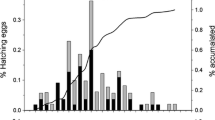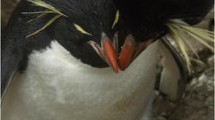Abstract
Seabirds exhibit considerable behavioural flexibility in foraging investment in order to meet the nutritional needs of their chicks during variable environmental conditions. Although regulation of offspring provisioning is generally thought to be related to species-specific constraints imposed by central place foraging, some studies suggest different responses within the same species linked to local differences in foraging conditions. Under adverse conditions, seabirds are expected to be less flexible because they must secure their own survival chances first before investing in current reproduction. Short-ranging single-prey loaders are expected to show large intra-specific variation in time spent on foraging because their mode of foraging is energetically expensive, and because they face restricted possibilities to increase the numerical prey input to the colony compared to multiple prey loaders. In this study, we examined if and how the single-prey loading Sandwich Tern Thalasseus sandvicensis varies colony attendance based on the nutritional status of their chick as well as parental body condition in two study colonies. The proportion of time that a chick was left unattended at the colony negatively correlated with chick body condition, suggesting that the parents tried to counterbalance poor feeding conditions by investing more time in foraging. Energy transport rates to the chicks (corrected for time spent away from the colony) and body condition of the chicks were similar in both colonies. However, at Zeebrugge, where adults were in poor body condition, parental non-attendance was much lower than on Griend, even when chicks were in poor condition. Still, our results suggest that parental nest non-attendance in Sandwich Terns is merely a corrective response to food loss to kleptoparasitic gulls in order to meet the nutritional status of the chick, although an effect of adult body condition could not be excluded.
Zusammenfassung
Innerartliche Anpassungsfähigkeit beim Elternaufwand in einem langlebigen Seevogel, der nur jeweils ein Beutetier im Schnabel transportieren kann
Seevögel zeigen sehr flexibles Verhalten im Aufwand der Futtersuche, um ihren Küken unter unbeständigen Umweltbedingungen ausreichend Nahrung zu beschaffen. Generell wird angenommen, dass die Regulation der Kükenversorgung abhängig ist von artspezifischen Einschränkungen bei der Futtersuche, die in einem Radius um die Brutkolonie stattfindet. Dennoch gibt es Studien, die auf innerartliche Unterschiede hinweisen, welche auf wechselnden Umweltbedingungen bei der Nahrungssuche beruhen. Es wird angenommen, dass Seevögel unter widrigen Bedingungen weniger flexibel reagieren, da sie zuerst ihr eigenes Überleben sichern müssen bevor sie in die Reproduktion investieren. Dabei wird erwartet, dass Arten mit kurzen Nahrungsflügen, die jeweils nur ein Beutestück transportieren können, eine hohe innerartliche Variation in der Dauer der Nahrungsflüge aufweisen, da bei ihnen die Nahrungssuche wesentlich aufwändiger ist und sie wenig Möglichkeiten haben die Menge an Beutestücken zu erhöhen, die in der Kolonie ankommen. In dieser Studie untersuchten wir in zwei Brutkolonien, ob und wie die Brandseeschwalbe Thalasseus sandvicensis ihre Anwesenheit in der Brutkolonie in Bezug auf den Hungerzustand ihrer Küken sowie der Körperkondition der Eltern anpasst. Die Zeit, in der die Küken unbewacht in der Kolonie zurückgelassen wurden, korrelierte negativ mit der Körperkondition der Küken, was darauf hin deutet, dass die Eltern versuchten die schlechten Nahrungsbedingungen durch längere Futtersuche auszugleichen. Energietransportraten an die Küken (korrigiert für die Zeit, die entfernt von der Kolonie verbracht wurde) und Körperkondition der Küken waren in beiden Kolonien ähnlich. Allerdings waren Altvögel at Zeebrugge in schlechter Körperkondition und elterliche Abwesenheit deutlich geringer als in Griend, selbst wenn Küken in schlechter Verfassung waren. Dennoch deuten unsere Ergebnisse darauf hin, dass die elterliche Abwesenheit vom Nest in Brandseeschwalben nur eine ausgleichende Reaktion auf den Verlust von Beute an kleptoparasitische Möwen ist, um den Ernährungszustand der Küken zu erhalten. Ein Effekt auf die Körperkondition von Altvögeln kann allerdings nicht ausgeschlossen werden.





Similar content being viewed by others
References
Bijleveld A, Mullers RC (2009) Reproductive effort in biparental care: an experimental study in long-lived Cape Gannets. Behav Ecol 20:736–744
Becker PH, Frank D, Wagener M (1997) Luxury in freshwater and stress at sea? The foraging of the Common Tern Sterna hirundo. Ibis 139:264–269
Bolton M (1995) Experimental evidence for regulation of food delivery to Storm Petrel, Hydrobates pelagicus, nestlings: the role of chick body condition. Anim Behav 50:231–236
Burke CM, Montevecchi WA (2009) The foraging decisions of a central place foraging seabird in response to fluctuations in local prey conditions. J Zool 278:354–361
Cairns DK (1987) Seabirds as indicators of marine food supplies. Biol Oceanogr 5:261–272
Dänhardt A, Fresemann F, Becker PH (2011) To eat or to feed? Prey utilization of Common Terns Sterna hirundo in the Wadden Sea. J Ornithol 152:347–357
Erikstad KE, Fauchald P, Tveraa T, Steen H (1998) On the cost of reproduction in long-lived birds: the influence of environmental variability. Ecology 79:1781–1788
Fasola M, Bogliani G (1990) Foraging ranges of an assemblage of Mediterranean seabirds. Colon Waterbirds 13:72–74
Granadeiro JP, Bolton M, Silvam MC, Nu-Nesa M, Furness RW (2000) Responses of breeding Cory’s Shearwater Calonectris diomedea to experimental manipulation of chick condition. Behav Ecol 11:274–281
Hamer KC, Hill JK (1994) The regulation of food delivery to nestling Cory’s Shearwaters Calonectris diomedea: the roles of parents and offspring. J Avian Biol 12:198–204
Hamer KC, Lynnes AS, Hill JK (1998) Regulation for chick provisioning rate in Manx Shearwaters: experimental evidence and implications for nestling obesity. Funct Ecol 12:625–630
Harding AMA, van Pelt TI, Piatt JF, Kitaysky AS (2002) Reduction of provisioning effort in response to experimental manipulation of chick nutritional status in the Horned Puffin Fratercula corniculata. Condor 104:842–847
Harding AMA, Piatt JF, Schmutz JA, Shultz MT, van Pelt TI, Kettle AB, Speckman AB (2007) Prey density and the behavioral flexibility of a marine predator: the Common Murre (Uria aalge). Ecology 88:2024–2033
Jodice PGR, Roby DD, Suryan RM, Irons DB, Turco KR, Brown ED, Thedinga KR, Visser GH (2006) Increased energy expenditure by a seabird in response to higher food abundance. Mar Ecol Prog Ser 306:283–293
Limmer B, Becker PH (2009) Improvement of chick provisioning with parental experience in a seabird. Anim Behav 77:1095–1101
Monaghan P, Walton P, Wanless S, Uttley JD, Burns MD (1994) Effects of prey abundance on the foraging behaviour, diving efficiency and time allocation of breeding Guillemots Uria aalge. Ibis 136:214–222
Navarro J, González-Solís J (2007) Experimental increase of flying costs in a pelagic seabird: effects on foraging strategies, nutritional state and chick condition. Behav Ecol 151:150–160
Phillips RA, Croxall JP (2003) Control of provisioning in Grey-headed Albatrosses (Thalassarche chrysostoma): do adults respond to chick condition? Can J Zool 81:111–116
Ricklefs RE, Schew WA (1994) Foraging stochasticity and lipid accumulation by nestling petrels. Funct Ecol 8:159–170
Ronconi RA, Burger AE (2008) Limited foraging flexibility: increased foraging effort by a marine predator does not buffer against scarce prey. Mar Ecol Prog Ser 366:245–258
Sæther BE, Andersen R, Pedersen HC (1993) Regulation of parental effort in a long-lived seabird: an experimental manipulation of the cost of reproduction in the Antarctic Petrel Thalassoica antarctica. Behav Ecol Sociobiol 33:147–150
Sénéchal E, Bêty J, Gilchrist G (2011) Interactions between lay date, clutch size, and postlaying energetic needs in a capital breeder. Behav Ecol 22:162–168
Stienen EWM (2005) Living with gulls: trading off food and predation in the Sandwich Tern Sterna sandvicensis. Alterra Scientific Contributions 15. PhD thesis, Rijksuniversiteit Groningen, Groningen
Stienen EWM, Brenninkmeijer A (1999) Keep the chicks moving: how Sandwich Terns can minimize kleptoparasitism by Black-headed Gulls. Anim Behav 57:1135–1144
Stienen EWM, Brenninkmeijer A (2002) Foraging decisions of Sandwich Terns in the presence of kleptoparasitising gulls. Auk 119:473–486
Stienen EWM, Brenninkmeijer A (2006) Effect of brood size and hatching sequence on prefledging mortality of Sandwich Terns: why lay two eggs? J Ornithol 147:520–530
Stienen EWM, Brenninkmeijer A, Geschiere CE (2001) Living with gulls: the consequences for Sandwich Terns of breeding in association with Black-headed Gulls. Waterbirds 24:68–82
Stienen EWM, van Beers PWM, Brenninkmeijer A, Habraken JMPM, Raaijmakers MHJE, van Tienen PGM (2000) Reflections of a specialist: patterns in food provisioning and foraging conditions in Sandwich Terns Sterna sandvicensis. Ardea 88:33–49
Takahashi A, Kuroki M, Niizuma Y, Watanuki Y (1999) Parental food provisioning is unrelated to manipulated offspring food demand in a nocturnal single-provisioning alcid, the Rhinoceros Auklet. J Avian Biol 30:486–490
Tveraa T, Sæther BE, Aanes R, Erikstad KE (1998) Regulation of food provisioning in the Antarctic Petrel: the importance of parental body condition and chick body mass. J Anim Ecol 67:699–704
Vanaverbeke J, Braarup AB, Braeckman U, Courtens W, Cuveliers E, Deneudt K, Goffin A, Hellemans B, Huyse T, Lacroix G, Larmuseau M, Mees J, Provoost P, Rabaut M, Remerie T, Savina M, Soetaert K, Stienen EWM, Verstraete H, Volckaert F, Vincx M (2011) Understanding benthic, pelagic and airborne ecosystem interactions in shallow coastal seas. “Westbanks”: final report. Belgian Science Policy Office, Brussels
Veen J (1977) Functional and causal aspects of nest distribution in colonies of the Sandwich Tern (Sterna s. sandvicensis Lath.). Behav Suppl 20:1–193
Waugh SM, Weimerskirch H (2003) Environmental heterogeneity and the evolution of foraging behaviour in long ranging greater albatrosses. Oikos 103:374–384
Wendeln H, Becker PH (1996) Body mass change in breeding Common Terns Sterna hirundo. Bird Study 43:85–95
Wendeln H (1997a) Allocation of parental duties and foraging behavior influence body condition of adult Common Terns, Sterna hirundo. Bird Behav 12:47–54
Wendeln H (1997b) Body mass of female Common Terns (Sterna hirundo) during courtship: relationships to male quality, egg mass, diet, laying date and age. Colon Waterbirds 20:235–243
Wernham CV, Bryant DM (1998) An experimental study of reduced parental effort and future reproductive success in the Puffin, Fratercula arctica. J Anim Ecol 67:25–40
Weimerskirch H, Chastel O, Ackermann L (1995) Adjustment of parental effort to manipulated foraging ability in a pelagic seabird, the Thin-billed Prion Pachyptila belcheri. Behav Ecol Sociobiol 36:11–16
Weimerskirch H, Fradet G, Cherel Y (1999) Natural and experimental changes in chick provisioning in a long-lived seabird, the Antarctic Prion. J Avian Biol 30:165–174
Weimerskirch H, Mougey T, Hindermeijer X (1997) Foraging and provisioning strategies of Black-browed Albatrosses in relation to the requirements of the chicks: natural variation and experimental study. Behav Ecol 8:635–643
Weimerskirch H, Zimmermann L, Prince PA (2001) Influence of environmental variability on breeding effort in a long-lived seabird, the Yellow-nosed Albatross. Behav Ecol 12:22–30
Acknowledgments
We like to thank all the people involved in collecting biometrical data and doing observations on Griend and at Zeebrugge. Especially, Hans Schekkerman, Hilbran Verstraete, John Habraken, John Schobben, Karin Geschiere, Nicolas Vanermen, Peter van Beers, Piet van Tienen, René Oosterhuis and Marc Van de walle spend many hours of observations in a hide near the colony. We thank Cees de Boer, Dirk de Boer, Dirk van Hollik, Dirk Kuiper, Jan van Dijk and Peter van Tellingen for their logistic support. The Agency of Nature and Forest (ANB) undertook regular maintenance of the colony site at Zeebrugge. The Port Authority Zeebrugge (MBZ) kindly gave permission to access the breeding sites. The Flanders Marine Institute (VLIZ) provided storage facilities for the field equipment. Ivy Jansen (INBO) gave statistical advice. Financial support for this study was provided by the Department of Maritime Access of the Flemish Government (AMT: 16EP/HS/4/2005 and related contracts) and the Belgian Science Policy Office (projects TROPHOS EV-BNZ-03 and Westbanks SD/BN/01A).
Author information
Authors and Affiliations
Corresponding author
Additional information
Communicated by O. Krüger.
Rights and permissions
About this article
Cite this article
Stienen, E.W.M., Brenninkmeijer, A. & Courtens, W. Intra-specific plasticity in parental investment in a long-lived single-prey loader. J Ornithol 156, 699–710 (2015). https://doi.org/10.1007/s10336-015-1170-0
Received:
Revised:
Accepted:
Published:
Issue Date:
DOI: https://doi.org/10.1007/s10336-015-1170-0




